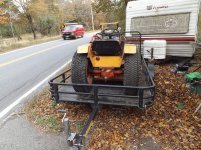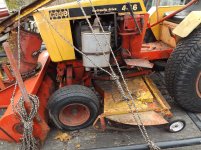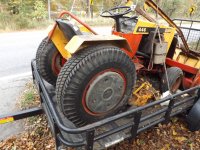Perhaps to you it isn't pretty but to me, it's beautiful.
First off, all of the tin looks to be in nice shape. The fenders
are not all bent from the improper use of tire chains.
None of the tin seems to be butchered in any way which
will make the restoration fairly easy. The only oddball
item is the switch on the right side of the dashboard but
that is easily filled in with a welder and ground flat. The
new dash decal will cover minor scars.
I'm glad you like what you see. Knowing that these details
are the way it was supposed to be makes a big difference
to me; which I didn't know before.
The Utility Blade is a mystery to me. I have never seen
an early-style blade that uses channel iron for the yoke.
All of the early-style blades used heavy-wall pipe. I don't
know if that blade is worth the effort to repair. For sure,
it is possible to patch the rotted section with some 1/8"
steel sheet welded over the damaged area but such a
patch does not aid in getting snow or dirt to flow over
the blade when it is angled.
Is it likely that it's not a Case implement? The most use
I'd have with this is grading my mostly sand driveway, and
maybe flattening some piles of dirt and anthills.
Not high on my list, but I'll probably get it welded up sometime.
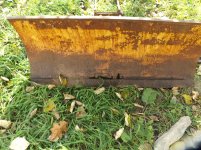
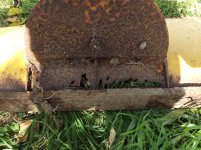 The snowcaster seems to be missing the chute crank handle,
The snowcaster seems to be missing the chute crank handle,
as well. The missing shaft and sprocket are not a big deal but
the missing pulley is because it is rather expensive. Rarely do
I ever see a snowcaster being parted out on e-Bay. Whether
you can find a low cost substitute pulley at a local supplier is
hard to say. We can get into that later. I think that the snowcaster
is a Model H, which is the first one that uses the Snap Fast system
which Case introduced in 1971.
What's the difference between a snowblower and a snowcaster and
other similar terms?
I have a orange pipe handle, and a wire rod handle as seen in the
pictures showing the missing shaft. The end support is bent up a
little too. The auger needs to come off, and have it's bearings replaced.
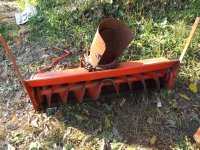
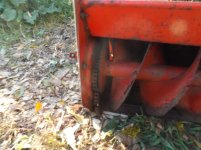
 You have no idea just how lucky you are. The exhaust system
You have no idea just how lucky you are. The exhaust system
is not only perfectly correct for this year of tractor but it is in
excellent shape. Those mufflers and pipes have been obsolete
for about ten or more years. The last time they were available,
the cost was more than $200.00 per side. Case used that cut-out
hood and muffler system from 1972 until early 1976.
I feel so lucky

I'm glad to know it's not some cobbled together arrangement.
I was wondering when I took a close look at it, it looked factory.
When I do need to replace this, what can I replace it with?
Once again, you have introduced a mystery to me.
The valve on the left side of the dash tower is called a
Flow Control Valve kit. Once again, I have never, ever,
ever seen this valve installed on any Colt, Case or Ingersoll
tractor unless the rear PTO valve was also installed. How
that happened boggles my mind because the Parts Manuals
always show the steel hydraulic lines which connect the two
valves together. A Flow Control Valve or FCV gives the operator
finite control over the forward motion of the tractor at very low
speeds. It is an option which is recommended by Case whenever a
Buyer wishes to add a rototiller to the tractor package but you
cannot power the tiller unless the optional rear PTO kit is also added.
It does come in handy when blowing snow and perhaps that was the
reason for it being there. I am curious as to whether this valve is
connected to steel lines or whether one or more hoses were used.
Well, I was told it was to direct the hydraulics to the front of the rear.
But I believe you are correct, especially since there aren't any hydraulic
fittings on the front of the back. It was probably added for snowblowing.
I've added a bunch of pictures of the piping going to the valve. it all looks
stock to me. I also ran across something on ebay called a holding valve
for a Case 446. What's that about?
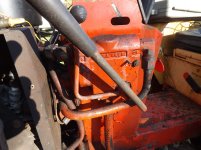
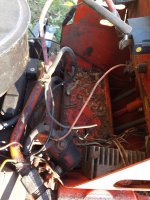
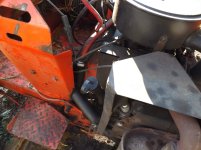
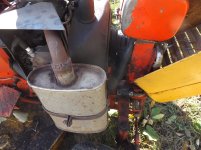
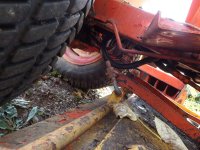
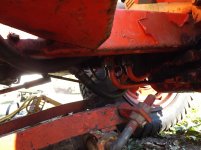 IF.... the tires are loaded with CC and no tubes were used,
IF.... the tires are loaded with CC and no tubes were used,
then that is a bad thing. CC will destroy the rims if allowed to
come in contact with it. Look at the valve stems to see if tubes
are used. Hopefully, the tires were loaded with windshield washer
antifreeze, which is not corrosive.
I was told there were no tubes in the tires, but the valve stems look
like tube stems. Tubeless valve stems bulge out before going into
the rim; these don't.
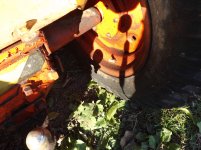 The mower deck is an H-Series which is the very first
The mower deck is an H-Series which is the very first
Snap Fast style of deck offered by Case. Therefore, it is correct
for this year of tractor. When you flip it over, there should be a
hard rubber roller at the rear of the deck in the middle. Quite
often, the brackets that support that roller wear through, thus
releasing the roller when the deck is raised off the ground and
the roller is lost forever.
There is no sign of there ever being a roller in the middle of the
back of the deck. There are wheels on the back two corners.

I did find a Operators Manual on the Internet, with a wiring diagram.
I've got to figure out why I don't have any spark. Where can I buy a
coil/distributor if I need one? I don't know if I can upload the manual
to this website...
Thanks again, Jim.
